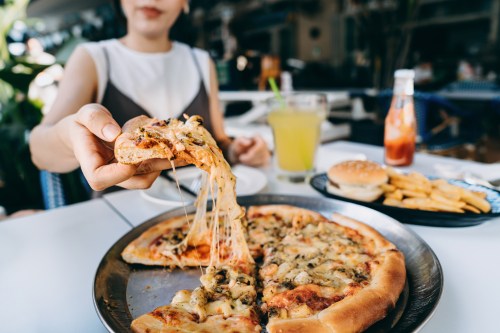POV: You’re eight years old, and your parents are giving you the side eye as you push the last bits of roasted Brussels sprouts around your plate with a fork. After delaying the inevitable for far too long, you finally commit to eating the bright green veggie. What the.
Indeed, it’s not just in your imagination that the Brussels sprouts you ate in your adolescence were, uh, potent, to say the least. In fact, although you may have been attributing it to your mother’s mediocre cooking skills or your maturing palate that has developed with age (hello, newfound love for black olives), it’s likely not the case at all. Rather, innovations in science can be thanked for the more palatable Brussels sprouts we know and love today. Ahead, we delve into the real reason why Brussels sprouts taste so much better than they did when we were kids and a few of our favorite ways to eat the nutritious and delicious veggie.
Why do Brussels sprouts taste so much better than when we were kids?
In a recent TikTok video by @rantsandrocks, they delve into the one main reason why Brussels sprouts taste so much better now than they did when we were kids. These days, roasted Brussels sprouts are on the menu of many fancy restaurants and are a staple ingredient in many of our meal prep routines. But looking back a few short decades ago, eating this green felt like an absolute chore.
That said, the creator behind Rants and Rocks says it’s not a figment of your imagination: It’s real science. In the video, they explain that in the 1990s, a Dutch scientist named Hans Van Doorn identified the chemicals that make Brussels sprouts bitter: sinigrin and progoitrin. After discovering this, the scientist worked to identify Brussels sprouts seeds and varieties with lower levels of these bitter chemicals. Then, Van Doorn bred out as much of the…ick factor…as possible (by using these less-bitter Brussels sprout seeds) and crossbred them with higher-producing varieties. The result? More Brussels sprouts that were less bitter. Genius.
In the 1990s, a Dutch scientist named Hans Van Doorn identified the chemicals that make Brussels sprouts bitter: sinigrin and progoitrin. After discovering this, the scientist worked to identify Brussels sprouts seeds and varieties with lower levels of these bitter chemicals.
Although Rants and Rocks goes on to say in the video that the reason why the once nearly impossible-to-eat bitter sprouts were no longer to be found by the 2010s was as a result of genetically modified organisms (GMOs), this isn’t the case. Rather, the “new” tastier Brussels sprouts we all know and love today, are a result of conventional breeding and Van Doorn’s crossbred creation, as we mentioned earlier. The difference? According to researchers, the main variance is that “conventional breeding develops new plant varieties by the process of selection, and seeks to achieve expression of genetic material which is already present within a species.” Meanwhile, genetic engineering (when creating GMOs) works primarily “through the insertion of genetic material, although gene insertion must also be followed up by selection.”
And although GMOs have often received a bad rap, like most things in life, there are two sides to every story, and GMOs are certainly one of them. While folks can ultimately argue both ways, scientists have not yet shown that GMO foods are harmful to health, but research is ongoing.
3 easy Brussels sprouts recipes to make them taste even better
1. Dijon-Braised Brussels Sprouts
Now that we’ve established that we are no longer forced to eat this green veggie—and now, we kind of love and eat ‘em willingly—this dijon-braised Brussels sprouts recipe is simple but, more importantly, downright delicious. The key? A bright and zesty five-ingredient vinaigrette made with Dijon mustard and apple cider vinegar. Best of all, all you have to do is toss the sprouts in the simple dressing (that you can whip together in a mason jar) and then let the oven do the rest of the work. One hour later, you’ll have perfectly roasted Brussels sprouts that are chewy on the inside, crispy on the outside, and entirely delicious throughout.
Get the recipe: Dijon-Braised Brussels Sprouts
2. Sesame Peanut Brussels Sprouts
What’s sweet, savory, and one of the best ways to eat Brussels sprouts? This sesame peanut Brussels sprouts recipe by The Kitchen Prep Blog. The easy recipe features a mix of ingredients like garlic, peanut butter, tamari, and honey, which are essentially an explosion of umami on your palate. The perfectly-balanced seasoning adds rich complexity to the veggie and makes eating more greens an effortless (and enjoyable) task.
Get the recipe: 5 Flavorful Brussels Sprouts Recipes
3. Fall Brussels Sprouts Slaw
Tired of eating roasted Brussels sprouts all the time and want to spruce things up? This Fall-inspired Brussels sprouts slaw recipe is the perfect option. (And, yes, it’s great no matter the time of year.) The trick to making this slaw as zero effort as possible is to use a food processor to pulse the veggie until it’s chopped into small, bite-sized pieces. Then, it’s made even more flavorful with toppings like toasted pumpkin seeds, almonds, grapes, and apples. Lastly, a tasty honey, olive oil, and cinnamon dressing helps to seal the deal on enjoying Brussels sprouts from here on out.
Get the recipe: Fall Brussels Sprouts Slaw
An RD shares a guide to eating to help reduce inflammation:
Sign Up for Our Daily Newsletter
Get all the latest in wellness, trends, food, fitness, beauty, and more delivered right to your inbox.
Got it, you've been added to our email list.











